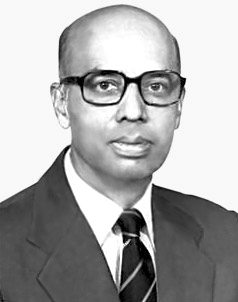|
Manali Kallat Vainu Bappu was born in Madras on August 10, 1927 as the only child of Manali Kukuzhi Bappu and Sunanna Bappu. Kukuzhi Bappu was an astronomer at the Nizamiah Observatory in Hyderabad. Vainu, in high likelihood, picked up the excitement of studying the mysterious cosmos from his father. Vainu attended the Harvard Graduate School of Astronomy for his PhD after his physics postgraduate degree from the University of Madras. He returned to India after a year of post-doctoral work at the Hale Observatories, Pasadena, USA, and was appointed to establish a modern observatory in Nainital.
 M.K. Vainu Bappu. |
Bappu left the Nainital Observatory to take over the directorship of the Kodaikanal Observatory in 1960. The Kodaikanal Observatory, started during the East India Company time (late 18th Century) under the leadership of Norman Pogson and John Evershed, badly needed modernisation. Under Bappu’s inspirational leadership, a group of young astronomers and astrophysicists joined him in revitalising the old Kodaikanal Obersvatory. Through Bappu’s efforts, it got up-to-date optical, electronic and mechanical gadgets and modern detectors and computers useful in observational work. By the early 1970s, a new observing station at Kãvalur was generating results comparable to other world-class observatories.
Bappu ambitiously planned for the growth of Indian astronomy. In addition to identifying thrust areas in astronomy and astrophysics, he actively popularised astronomy among the young. He worked under severe financial constraints when he directed the Kodaikanal Observatory. To make things viable in spite of severe financial constraints, he marshalled the design and fabrication of a 93" telescope in India, which was commissioned in 1983 – a year after his death.
While working as a Carnegie Fellow at the Hale Observatories in 1957, he published a paper along with the American astronomer Olin Chaddock Wilson, which blazed new trails. This finding was later recognised as the Wilson-Bappu effect. The Wilson-Bappu paper opened the field of stellar chromospheres for new astronomical research. Bappu, along with Bartholomew J. Bok and Gordon A. Newkirk, discovered the Bappu-Bok-Newkirk comet. He was awarded the Donhoe Comet Medal by the Astronomical Society of the Pacific in 1949. He was instrumental in the establishment of the Indian Institute of Astrophysics in Bangalore. The Kavalur observatory, now known as the Vainu Bappu Observatory, celebrates Vainu’s remarkable contributions to Astronomy. Vainu died in Münich on August 19, 1982.
Bappu’s work won recognitions both in India and overseas. He was elected as an Honorary Foreign Fellow of the Belgian Academy of Sciences and an Honorary Member of the American Astronomical Society. He was Vice-President of the International Astronomical Union (1967–1973) and became its President in 1979, the only Indian astronomer to achieve this distinction.
Vainu’s colleague and a close associate, J.C. Bhattacharya, had the following to say when Vainu died: “In his untimely death, astronomy has lost one of its most ardent practitioners who spared no efforts in the attainment of its aims.” Madras needs to look back with pride that men of science of such calibre and quality as Vainu have grown in its lap.
|